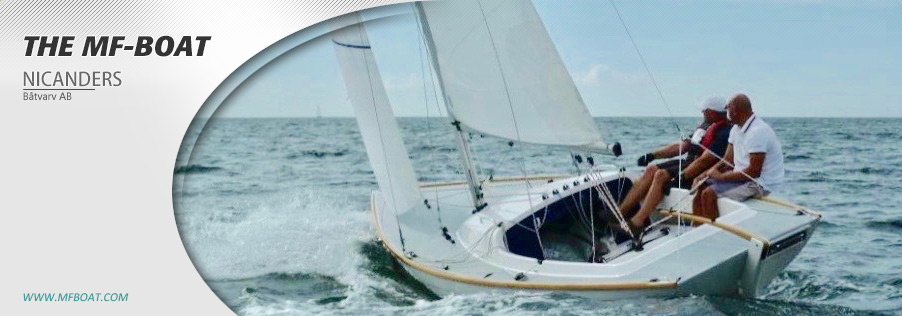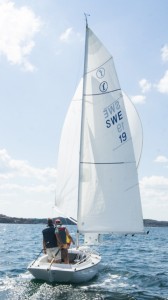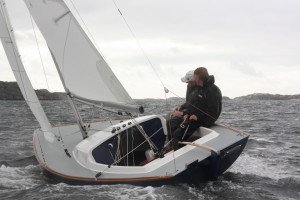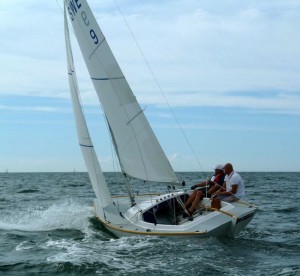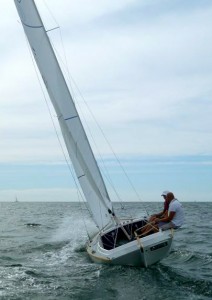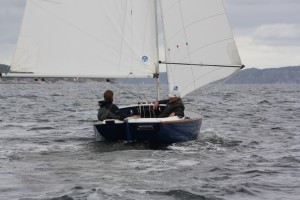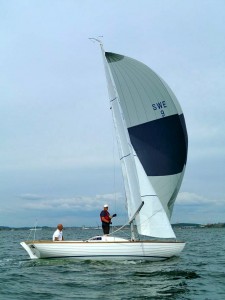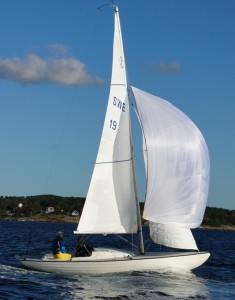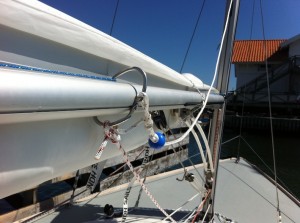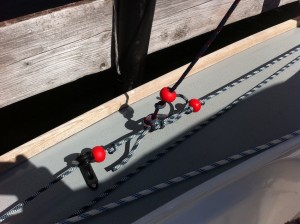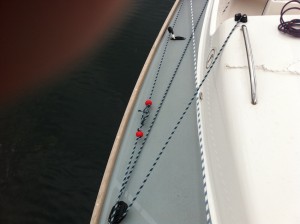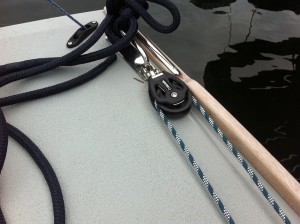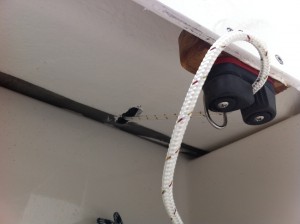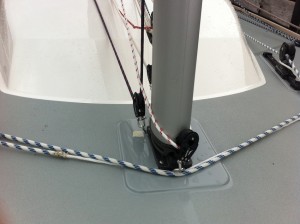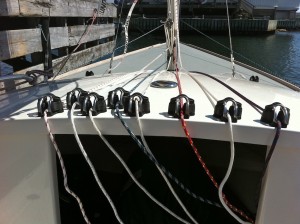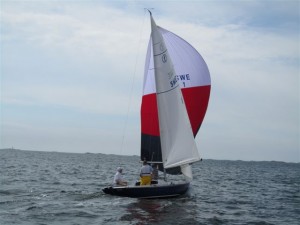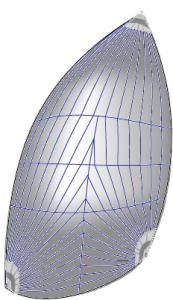Tuning your MF-boat
Photo courtesy: Tommy Ekerum
General tuning advises for sailing in different conditions. Check this out before sailing the first time!
The MF-boat is generally very well balanced and light on the helm on all points of sail. Helm balance is adjusted with the sail and rig trim and the positioning of the crew. The ideal positioning of the crew, on all points of sail, should be such as the boat is floating parallell to it´s designed waterline.
Mast and rig
It is very important that the mast is correctly tuned, not only for safety, but also for the performance of the boat.
The standard mast rake is fixed by the length of the forestay. The length of the forestay may be increased using toggles if more mast rake is desired. The shroud tension can be adjusted with the rigging screws. To obtain a standard trim, tighten the upper shroud rigging screws on both sides. (measure the length of the screws to obtain the same tension on both starboard and port sides) Don’t tighten excessively. Tighten the lower shrouds slightly less than the uppers. Tighten the jumper stays ( when mast is down) moderately. When sailing the first time, check how the mast looks under load, sailing to windward in moderate air, about 10 knots, with the backstay slack. When you look up close to the mainsail luff groove, the mast should be straight sideways. If the top falls to leeward, tighten the jumper stays. If the top bends forward, ease the jumper stays. If the lower part of the mast falls to leeward or bends to windward, adjust the lower shrouds until the mast is straight sideways on both tacks.
It is normal that the rig tension decreases a little after some hours of sailing, because the rig sets a little when new. Adjust by tightening the shrouds again. However, it is normal with a little slack in the leeward upper shroud in a breeze, even if the shrouds feel tight when the rig is not under load.
Perfect helm balance!
Photo courtesy: Tommy Ekerum
Sail trim
Going to windward 0-6 knots
In light air it is important not to tighten halyards and sheets too much, especially if the sea is sloppy. It is also important to position the crew to leeward and forward in the cockpit or on deck in order to generate some heeling. Tighten the mainsail halyard but leave some wrinkles along the luff. Pull the mainsheet so the boom comes close to the centerline and put the mainsheet traveler amidships and pull it eventually to windward, simultaneously easing the mainsheet slightly to obtain some twist in the leech, ie battens nr 1 and 2 from the top should be about parallell to the boats centreline or point slightly to leeward. It is not necessary to tighten the backstay. Tighten the mainsail foot until about 5 cm from the black band on the boom end.
Tighten the jib halyard until the wrinkles at the hooks just start to disappear. Sheet the jib lightly with the traveler placed forward of the track center. The jib should be sheeted with a little “twist”, like the mainsail.
7-14 knots
Tighten the main and jib halyards until the wrinkles along the luff disappears. (use the cunningham control line to tighten the mainsail luff if necessary) Sheet home harder in both sails, but do not tighten excessively. Tighten the mainsail foot almost all the way to the black band. The backstay can remain slack under these conditions. Move the jib traveler somewhat aft if necessary. In a seaway, remember to tighten a little looser than on flat water, allowing a little more twist in both sails.
Upwind sail trim at 8 – 14 knots of true wind.
15-20 knots
Heeling is negative to the performance of all sailboats and in heavy air the most important thing is to control the heeling. The positioning of the crew to windward is essential, so is the sail trim. Tighten the halyards even more. (use the cunningham control line to tighten the mainsail luff if necessary) Sheet harder in both main & jib. Tighten the kicking strap so the leech remains tight when releasing the mainsheet in a gust. Tighten the mainsail foot all the way to the black band. Check there are sufficient twist in both sails especially in a seaway. Point high on the wind and ease the mainsheet to control the gusts. Adjust helm balance by pulling the backstay if necessary.
In heavier air it will become necessary to reef the mainsail. It will then also become flatter that results in less heeling and makes the boat easier to steer. Reefing is done by connecting the clew and tack rings on the reef reinforcement patches to the outhaul car and to the gooseneck fitting. Surplus sailcloth is tied to the boom using the eyelets in the sail. Be careful to tighten halyard and foot until wrinkles disappear. Also tighten the leech lines if flapping occurs.
Light downwind
Set the kicking strap lightly; the mainsail leech should be allowed to flex slightly. Ease the control line for the mainsail foot, letting it 5-10 cm from the black band. The main halyard should be eased leaving some wrinkles along the luff.
Also ease the jib halyard until wrinkles start to appear at the hooks.
Position the crew forward in the cockpit, if more than three persons aboard, one could eventually sit on foredeck.
Use the jib pole to sheet the jib to windward when sailing dead downwind or close. The pole is first connected to the jib clew, then to the mast ring, after which the sail is sheeted in. When gybing, first gybe the mainsail, thereafter the jib by disconnecting the pole from the mast, taking it aft to pass the forestay, connect again to the mast on the new tack, while adjusting the jib sheet.
Photo courtesy: Tommy Ekerum
Heavy downwind
Tighten the main halyard and the foot. Tighten the kicking strap to prevent the upper part of the mainsail to fall to leeward. Set the backstay for safety. Be careful not to sail a course too close to dead downwind in heavy air, which can result in oscillation. A slightly higher course is always safer. The crew inside the cockpit to lower centre of gravity.
Square to the wind
Square to the wind is a course 90 degrees to the true ( meteorological ) wind. As the forward movement of the boat generates a wind in the opposite direction, it modifies the direction of the true wind to a more narrow angle. The new wind is called the apparent wind and this is the wind that we feel blowing across deck. Sailing square to the wind requires the kicking strap to be tightened, especially when the wind speed picks up, to prevent the boom end to point upwards and the upper part of the mainsail to fall off to leeward and flap, which means loss of power. If the kicking strap is tightened, the mainsheet can be eased more, resulting in less heeling, thus more speed. Flapping also means wear, so it should be prevented at all times. The sails are eased until the luff starts to bubble, then sheeted in slightly. Steer towards the destination and adjust the sails as wind strength and direction varies.
Sailing with the spinnaker
There are two spinnaker sizes: 37 m2 and 22 m2. The 37m2 spinnaker is hoisted almost at the masthead. Despite its size it does not feel to heavy to sheet in, as the boat is easily driven and the speed increase under spinnaker gives less force in the sheets. The larger spinnaker is intended for sailing in moderate/fresh winds, up to around 8 m/s. Stronger wind demands a very experienced crew. The 22m2 spinnaker is hoisted just above the jumper, where a block is fitted to the mast. Through its smaller size it is much easier to handle even in strong winds and we recommend this size for sailing schools for example.
Here is a description how to handle the spinnaker when hoisting and taking it down, and how to trim it efficiently.
Checking the spinnaker equipment
Prior to sailing, check that the spinnaker equipment is correctly installed: spinnaker pole, sheets, tweakers, halyard, spinnaker pole lift and – downhaul.
Spinnaker pole
Pole stored on main boom with lift and downhaul lines attached
The spinnaker pole is stored on the side of the main boom. Fittings for this are installed as standard. The release line to open the ends should be fixed to the middle of the pole, to avoid opening both ends at the same time. Lift and downhaul lines should be tied with bowline to the center of the pole, and can remain attached when pole is stored, ready for use.
Sheets
The sheets should have a plastic ball at about 200 mm from one end, with stop knots. The end should be tied to the spinnaker clews with bowline. Tweakers should be led through deck amidships and to the cam cleat mounted under the coamings each side. The spinnaker sheet should run through the tweaker block, then through the single block schackled to the aft mooring cleat, then forward through the ratchet block amidships and finally through the cam cleat on the cabin top.
Sheets and halyard with plastic balls (left) and spinnaker sheet arrangement (right)
Lead block aft ( left) and tweaker cleat under coaming (right)
Halyard, pole lift and -downhaul
Lead blocks for halyard, lift and downhaul at mast step, and right, cleats on cabin top
The spinnaker halyard, pole lift & downhaul should run through lead blocks at the mast step and then to the cam cleats on the cabin top. Halyard and lift lines should both have a plastic ball near the end, same as the sheets. The ball should be there to prevent the line to disappear into the mast accidently, and the balls on the sheets are supports against the pole end fittings. Tie the halyard to the spinnaker head, the lift to the pole and the downhaul line to the pole using bowlines.
Prepare for hoisting
Check that the head and the clews are not twisted. This is done by following the leech tapes one by one and at the same time store the spinnaker in the bag letting head and clews hang outside the bag. Attach the bag to the boat. The spinnaker may also be stored loose laying under the cabin with halyard and sheets attached.
Hoisting the spinnaker
Take the windward sheet around the forestay and aft to the cockpit. The easiest way is to tie both sheet ends and the halyard end together, so the whole package can be hauled around the forestay to either side of the cockpit. Tie halyard and sheets to the spinnaker. Bear away and snap the windward sheet into the outer pole end fitting. Attach the spinnaker pole to the mast and pull the lift line until the pole is about square to the mast. Lock the downhaul line in the cam cleat.
The sail is hoisted while the windward sheet is pulled and the leeward sheet is relaesed.
Check that the spinnaker is hoisted all the way to the halyard sheave.Hold the course, pull the windward sheet and release the leeward sheet until the spinnaker luff is starting to curl.
A simple rule of thumb to fly the spinnaker:
– Pull out the pole to windward until it is about parallell to the main boom for any given course.
– Release the leeward sheet until the luff starts to curl, pull the sheet slightly and adjust the spinnaker leeward sheet continously for maximum performance.
Adjusting the spinnaker pole height
– Adjust the height of the pole end for different wind strengths. Starting position is square. Rule of thumb: light winds – lower the pole end; Stronger winds – lift the pole end. However, do not lift or lower the pole eccessively, the difference between light and stronger wind is about half a meter.
Tweakers
The tweakers are there to stabilize the spinnaker on open downwind legs and to reduce the force in the downhaul line, which unloads the pole. Release the leeward tweaker when reaching, otherwise the spinnaker leech will be too closed.
Dropping the spinnaker
The safest way to drop the spinnaker is sailing downwind at about 140-180 degrees apparent. Such a course is advisable especially in stronger winds.
Drop to leeward:
– Release windward sheet until the pole is close to the forestay.
– At the same time, pull the lee sheet to stretch the foot of the sail. ( leeward tweaker to be released)
– Realease the halyard
– Quickly pull the spinnaker down behind the mainsail and collect it ( below the cabin) while releasing the windward sheet.
Drop to windward:
– Detach the spinnaker pole from the mast and windward sheet and store it on the main boom. The spinnaker remains “free flying” for a while.
– Grab the windward sheet, release the halyard and collect the spinnaker quickly while releasing the leeward sheet.
A second crewmember may help at some moments, to salvage the sail safely.
Sailing the spinnaker in light and stronger winds and at different angles.
In light air it is easy to control the boat with the spinnaker set. Even close reaching is not a problem. The spinnaker may be flown with loose sheets, far out from the boat when sailing an open downwind leg.
In fresh air, however, close reaching may be difficult. The boat is heeling and the mainsail has to be released in order to reduce power. If the wind is strong enough and the course high enough one may loose steering control of the boat. It rounds up against the wind heeling strongly with the spinnaker flapping. In this situation it is almost impossible to bear away and drop the spinnaker. The best ( and only) way to sort it all out is to quickly release the spinnaker halyard completely, then bear away and pull in the leeward sheet and collect the spinnaker into the boat while releasing the windward sheet. The absolutely worse thing to do is to release the windward sheet first – it results in the spinnaker filling aft of the boat – an even more difficult situation to sort out.
On open downvind legs in fresh air it is also preferable to fly the spinnaker close to the boat, in order to avoid oscillation caused by the spinnaker movements sideways. Here the tweakers are very helpful. Also make sure to tighten the backstay to stabilize the rig when the spinnaker is pulling. Check the slack in the forestay!
Do not steer a course too close to 180 degrees. This may result in oscillation, especially in a seaway. A course close to 180 degrees may also cause an uncontrolled gybe.
NB! Be observant if the wind increases. Steer a lower course or drop the spinnaker.
Gennaker
The gennaker size is 29 m2 and it is intended for downwind sailing and close reaching. I has rounded luff and leech which makes it less suitable for close-hauled sailing.
The gennaker is handled with the same equipment as the spinnaker. The tack is attached to the forward mooring cleat, eventually with a 500 mm strap, and the sheet blocks are attached to the aft cleats. The tweakers are set loose on the leeward side.The sheets are both attached to the clew.
Tuning a boat is individual, of course, these guidelines serve as general information. Variations can be many when many people find out how to sail the MF-boat. Tell your friends to get themselves an MF and you will enjoy some thrilling racing together!!
Sail care
After a day of sailing, roll the mainsail and tie it on the boom with straps. The easiest way is to stand on deck or on the cabin top and fold the sail at batten 1 or 2. Thereafter the sail is rolled over the boom so the battens are kept parallell to the roll and the boom.
The jib is rolled the same way and stowed under deck or on the boom together with the mainsail.
If the sails have become wet leave them to dry for a while on deck before rolling them, or take them ashore and spread them out. Do not leave the sails to dry flapping in the wind, as flapping is harmful to the sailcloth and should be avoided at all times.
